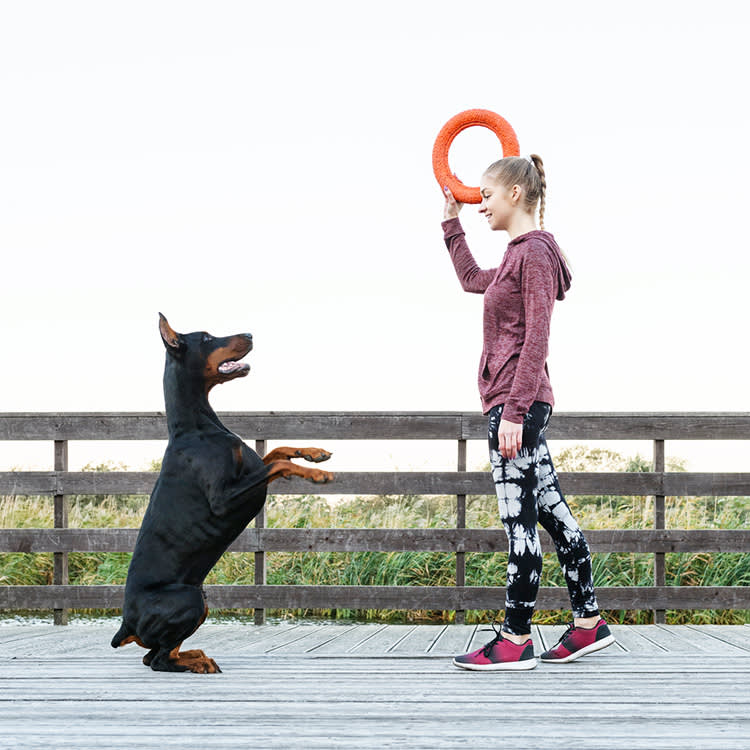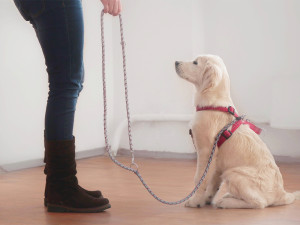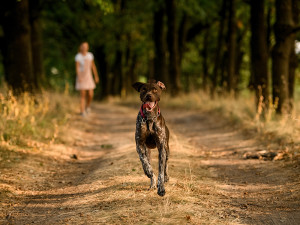How to Work Out What ‘Drives’ Your Dog
You might already have a good idea of what your dog likes, but it‘s not always that straightforward

Share Article
Ever wondered, “What on earth is going on inside that adorable little head?” when looking at your pup? (When they’re undoubtedly looking back at you with that curious head tilt.) Whilst we can’t (sadly) read their minds, we can understand a bit more about the drives, motivations and instinctual behaviours that influence their sometimes downright unusual actions.
Understanding what motivates your dogopens in a new tab is essential for effective training and a harmonious relationship between pup and pet parent. In the world of canine behaviouropens in a new tab, the term ‘drive’ is often used to describe the intensity of an instinct displayed by a dog. We delve into the intricacies of what drives your dog, exploring the different motivations that influence your pup’s behaviour and provide insights from experts to help you decode and work with your furry friend’s instincts.

Get (totally free) deals for food, treats, accessories, tech and way more pet parenting must-haves.
opens in a new tabWhat is a drive?
First and foremost, what is a dog’s drive? Evangelos Diamantakosopens in a new tab, a clinical animal behaviourist and senior lecturer at Hartpury University, clarifies that ‘drive’ is a term used to measure the intensity of instincts displayed by a dog. These instincts fall under three primary categories – self-preservation, social and sexualopens in a new tab (reproduction) – and manifest in a variety of behaviours, including eating, playing, hunting and exploring.
“We generally use the term ‘drive’ when assessing the level of an instinct exhibited by a dog,” says Evangelos. “For instance, we often say that a dog has a high prey drive when describing its keen interest in chasing a moving object, such as a ball.
“Thus, the term ‘drive’ is commonly associated with the intensity of an instinct displayed by a dog. In our efforts to characterise the level of a drive, we use adjectives such as high, medium and low (eg, very high defence drive, or medium-low fight drive).”
Dr Katie Friel-Russell, a veterinary behaviourist and head trainer at Positive Pet Trainingopens in a new tab, adds, “When we talk about drives for training, we can mean the things that reinforce their behaviour. What makes them more likely to do what they’re doing, or what would they choose to do if they could pick.”
What types of ‘drives’, or motivations, are there?
Common drives include food and play – often split into chasing, tug or retrieving – which, Dr Friel-Russell explains, emphasises the role of the predatory motor pattern in understanding these drives. This pattern sequence includes stalking, chasing, biting, killing, holding or carrying, and eventually eating. Different dogs may focus more on specific steps in this process, resulting in variations in their motivations to reinforce certain behaviours.
Dogs are motivated by the need to exhibit instinctual behaviour. Under the three basic instincts (self-preservation, social and reproduction), “We can observe that dogs exhibit a wide variety of sub-instincts, such as eating, playing, fighting, retrieving, hunting, exploring, packing, defending, competing, protecting, fearing, ‘flight’ (running away), possessing and evaluating situations, etc,” says Evangelos.
How do you work out what drive your dog has?
Understanding your dog’s drives is essential for effective training. You probably already have a good idea of what your dog likes and which aspects of the predatory sequence are most important to them (hello Labrador scoffing down anythingopens in a new tab in sight), but it‘s not always as straightforward as you might think.
Evangelos recommends assessing a puppy’s responses to food presentation and moving objects at an early stage (around four weeks) to determine the levels of the ‘eat drive’ and ‘prey drive’. “Explore how the puppy responds to food presentation and moving objects,” he explains. “The first aims to assess the level of the instinct to eat (eat drive), and the second aims to assess the level of the drive to chase a moving object (prey drive).”
“There are lots of breed dispositions where certain breeds have been selected to focus on one or more areas,” adds Dr Friel-Russell. “For example, Collies and herding breeds on the chase, and Labradors on the hold and, more importantly, the consume aspects.”
“But we also know that we get plenty of variation within a breed as well as between breeds,” she adds, suggesting observing your pup on walks and offering games that target different aspects of the predatory sequence to help identify their preferences. Monitoring your dog’s excitement and experimenting with various treats and toys can provide insights into their preferences.
How can you work out what drives dogs that don’t seem like they have any drive?
For dogs that appear to lack motivation, in particular nervous or rescue dogs, Evangelos advises patience. These dogs may be solely focused on survival aspects due to fear, discomfort or previous experiences, and understanding their background is vital. Patience, timing and a tailored approach respecting the dog’s pace are key.
Dr Friel-Russell adds that even the most withdrawn or injured dogs need to eat, making food a valuable tool to work with them.
“Often scared dogsopens in a new tab or dogs in painopens in a new tab are solely focussed on the survival aspect of the drive, says Dr Friel-Russell. “This means they can’t show preference for other things so easily as they are too distracted. But even the most shut down animals need to eat, so you can always use their food to work with them and find the foods they enjoy the most to enrich their lifeopens in a new tab in the meantime.”
Can you ‘instil’ a drive?
While some aspects of the predatory sequence can be encouraged, the innate drives a dog is born with remain fundamental. Motivations in dogs are a combination of inherited (genetic) and acquired (learnt) characteristics, and whilst there is definitely the potential to increase the intensity of instinctive behaviour, as well as experiment with different motivations, Dr Friel-Russell notes that innate drives persist, making it challenging to completely alter them.
“You can try to encourage different aspects of the predatory sequence in your dog and many dogs will learn to enjoy other aspects and this gives you another string to your bow to use when training with your dog,” she explains. “But those innate drives your dog was born with are likely to persist and be the most important to them throughout their lives.”
Imprinting, where a puppy mimics the behaviour of an older dogopens in a new tab, is a powerful way to instil a certain behaviour, says Evangelos, but carefully planning the training process, using positive reinforcement and understanding the dog’s preferences is key.
How does training differ for each drive?
Understanding your dog better in any way allows for a more personalised training plan, but tailoring your training plan based on a dog’s drives can also enhance its effectiveness. Using high-value reinforcers based on your pup’s motivations and adjusting the difficulty level of training based on a dog's ability to cope with distractions in relation to their drives is also crucial.
“Depending on your dog’s drives it can influence what you use to reinforce behaviours for your dog,” says Dr Friel-Russell. “Using higher value reinforcers, or rewards, can help your dog learn faster. A Labrador is going to find it much harder waiting when there are treats on the floor, compared to a Collie waiting while a ball is thrown, or a Terrier waiting for a chase. By understanding their drives you can incorporate it and personalise their training plan.”
Can you pull back on a drive?
Dr Friel-Russell suggests managing, not reducing, a dog’s drive to ensure appropriate outlets. Attempting to restrict access to a specific drive may increase its value, making dogs more likely to exhibit that drive in undesirable situations. Instead, she recommends providing opportunities for dogs to express their normal behaviours while incorporating self-control training.
This approach helps dogs manage their behaviour in situations where their drives may be triggered. For example, allowing a dog chasing opportunities and teaching a stop cue during play can lead to better behaviour management in situations where the instinct may pose a challenge, such as walking near livestock.
Understanding your dog’s drives is a journey, but by decoding their instincts and motivations, and appreciating the unique combination of genetic and learnt characteristics, pet parents can create a motivating environment that fosters positive behaviour and a strong bond between you and your four-legged friend.

Orla Pentelow
Orla Pentelow is Kinship UK’s Senior Editor. She has previously written for British Vogue, Bustle, Yahoo and The Telegraph. When not at her desk liking dog videos she’s out and about with her rescue pup, Luna, who works primarily as chief distractor.
Related articles
![Dog laying on the ground guarding toy in mouth]() opens in a new tab
opens in a new tabHow to Get Your Dog to Stop Resource Guarding Their Stuff
If your dog growls when you get near their food or toys, read this right now
![woman in running gear petting a small dog in a park]() opens in a new tab
opens in a new tabWorkouts You Can Do With Your Dog – From Doga to Canicross
Walking is fun, but let’s kick things up a gear
![Brown dog with merle coat running towards the camera on a forest path with a woman standing in the fall distance calling out to him]() opens in a new tab
opens in a new tab“How Do I Get My Dog to Come When Called?”
Dog trainer Robert Haussmann’s tips for getting a stubborn pup to listen up
![Young woman sitting at desk petting her senior Great Dane]() opens in a new tab
opens in a new tabHow to Speak ‘Dog’
Lili Chin’s book, Doggie Language, illustrates how dogs communicate – beyond ear perks and tail wags
![Guy sitting with his dog at his desk at work.]() opens in a new tab
opens in a new tabHow to Train Your Dog For a Day At the Office
Dog trainer Robert Haussmann shares his tips for how to teach your pup to be your favourite co-worker










